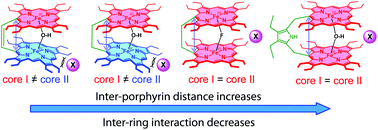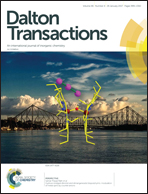Hydroxo-bridged diiron(iii) and dimanganese(iii) bisporphyrins: modulation of metal spins by counter anions†
Abstract
The chemistry of oxo/hydroxo-bridged diheme centers, connected covalently through bridges, has attracted much attention recently. Close approach of the two heme centers in the μ-hydroxo complex results in an unequal core deformation which leads to the unusual stabilization of two different spin states of iron in a single molecular framework. The spin states are also counter-anion specific and are reversibly interconvertable. An increased separation between the heme centers, however, leads to a weaker inter-ring interaction and, hence, renders the iron centers equivalent. The counter anion has been found to perturb the spin state ordering of iron via H-bonding interaction, switching positions between counter anion and axial ligand, ion–dipole interaction, charge polarization etc. A tightly associated counter anion with one of the heme centers generates significant steric effect in both the solid state and solution and induces significant change in the structure and properties, including the iron spin state, without affecting the overall topology of the complex or the metal oxidation state. A brief account of our systematic investigation on this subject is presented in the present Perspective article.

- This article is part of the themed collection: 2017 Frontier and Perspective articles

 Please wait while we load your content...
Please wait while we load your content...